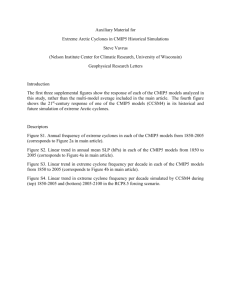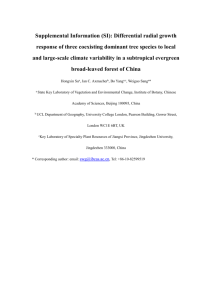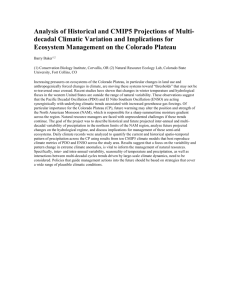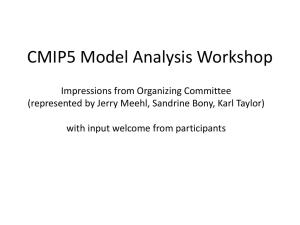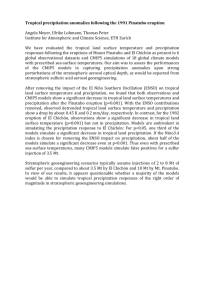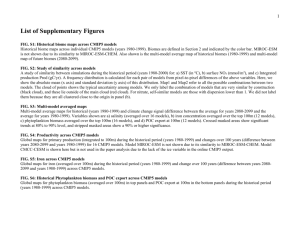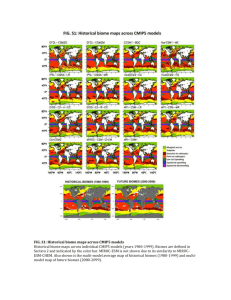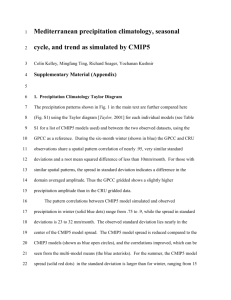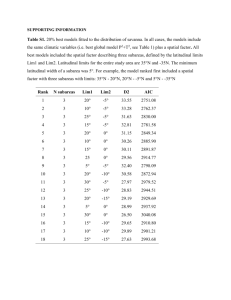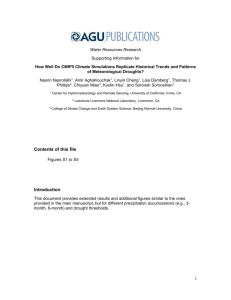1 Physical Oceanography Laboratory/Qingdao Collaborative
advertisement
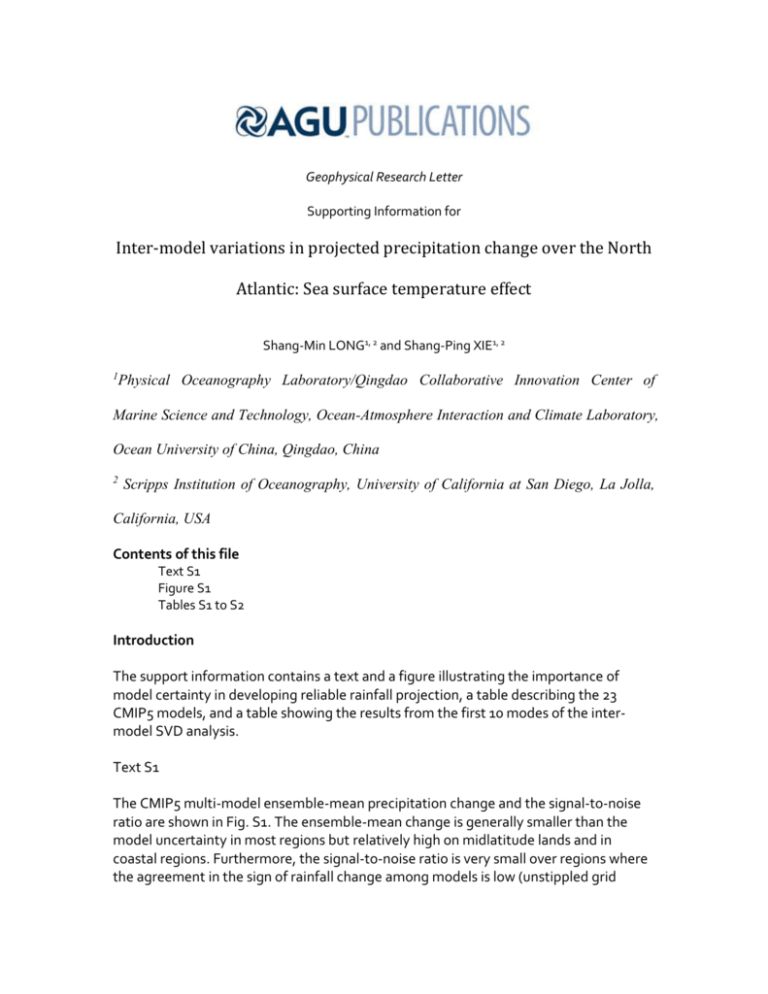
Geophysical Research Letter Supporting Information for Inter-model variations in projected precipitation change over the North Atlantic: Sea surface temperature effect Shang-Min LONG1, 2 and Shang-Ping XIE1, 2 1 Physical Oceanography Laboratory/Qingdao Collaborative Innovation Center of Marine Science and Technology, Ocean-Atmosphere Interaction and Climate Laboratory, Ocean University of China, Qingdao, China 2 Scripps Institution of Oceanography, University of California at San Diego, La Jolla, California, USA Contents of this file Text S1 Figure S1 Tables S1 to S2 Introduction The support information contains a text and a figure illustrating the importance of model certainty in developing reliable rainfall projection, a table describing the 23 CMIP5 models, and a table showing the results from the first 10 modes of the intermodel SVD analysis. Text S1 The CMIP5 multi-model ensemble-mean precipitation change and the signal-to-noise ratio are shown in Fig. S1. The ensemble-mean change is generally smaller than the model uncertainty in most regions but relatively high on midlatitude lands and in coastal regions. Furthermore, the signal-to-noise ratio is very small over regions where the agreement in the sign of rainfall change among models is low (unstippled grid points). The domain mean (80°W-0°, 20°N-60°N, ocean only) signal-to-noise ratio is 0.63, 0.68 and 0.65 for annual, DJF and JJA means, respectively. Fig. S1 (Left panels) The CMIP5 multi-model ensemble mean precipitation change (color shaded) and inter-model standard deviations (black contours). (Right panels) Signal-to-noise ratio, defined as the absolute value of the ensemble mean precipitation change (Em) divided by the inter-model standard deviation (Std), black contours indicate value at 1. In (d-f) grid-points where at least 15 models agree on the sign of the ensemble mean change are marked with dots. Results are based on annual-mean in (a and d), DJF-mean in (b and e) and JJA-mean in (c and f). All results are normalized by the domain mean (80°W-0°, 20°N-60°N) SST warming. Table. S1. List of 23 models from CMIP5 analyzed in this study. * and x denote nearsurface humidity and wind speed outputs are not available in the model, respectively. Model Name Modeling Center (or Group) ACCESS1.0 ACCESS1.3 BCC-CSM1.1 BCC-CSM1.1(m) BNU-ESM CanESM2 CCSM4 CESM1-BGC CESM1-CAM5 CMCC-CM x x * CNRM-CM5 GFDL-CM3 HadGEM2-ES IPSL-CM5A-LR IPSL-CM5A-MR IPSL-CM5B-LR MIROC-ESM Commonwealth Scientific and Industrial Research Organization (CSIRO) and Bureau of Meteorology (BOM), Australia Beijing Climate Center, China Meteorological Administration College of Global Change and Earth System Science, Beijing Normal University Canadian Centre for Climate Modelling and Analysis National Center for Atmospheric Research Community Earth System Model Contributions Centro Euro-Mediterraneo per I Cambiamenti Climatici Centre National de Recherches Météorologiques / Centre Européen de Recherche et Formation Avancée en Calcul Scientifique NOAA Geophysical Fluid Dynamics Laboratory Met Office Hadley Centre (additional HadGEM2-ES realizations contributed by Instituto Nacional de Pesquisas Espaciais) Institut Pierre-Simon Laplace MIROC-ESM-CHEM MIROC5 MPI-ESM-MR * MRI-CGCM3 NorESM1-M x NorESM1-ME x Japan Agency for Marine-Earth Science and Technology, Atmosphere and Ocean Research Institute (The University of Tokyo), and National Institute for Environmental Studies Atmosphere and Ocean Research Institute (The University of Tokyo), National Institute for Environmental Studies, and Japan Agency for MarineEarth Science and Technology Max-Planck-Institut für Meteorologie (Max Planck Institute for Meteorology) Meteorological Research Institute Norwegian Climate Centre Table. S2. Spatial correlation and explain variance in the first 10 inter-model SVD modes. Annual-mean Spatial correlation (ΔP, ΔSST) (ΔP, RegΔE) DJF mean JJA mean Explained variance (ΔP, ΔSST) ΔP ΔSST SVD1 0.79 0.89 27.7% 30.8% 0.82 0.22 SVD2 0.65 0.72 20.9% 26.7% 0.68 0.35 SVD3 0.64 0.78 12.5% 13.4% 0.74 0.11 SVD4 0.63 0.64 6.3% 5.3% 0.75 0.30 SVD5 0.64 0.73 5.6% 3.6% 0.52 -0.09 SVD6 0.52 0.65 5.1% 3.4% 0.72 0.53 SVD7 0.69 0.73 2.9% 4.8% 0.13 0.38 SVD8 0.65 0.80 2.7% 2.7% 0.41 0.30 SVD9 0.32 0.31 3.4% 2.1% 0.31 0.02 SVD10 0.50 0.61 2.0% 1.2% 0.68 0.18
